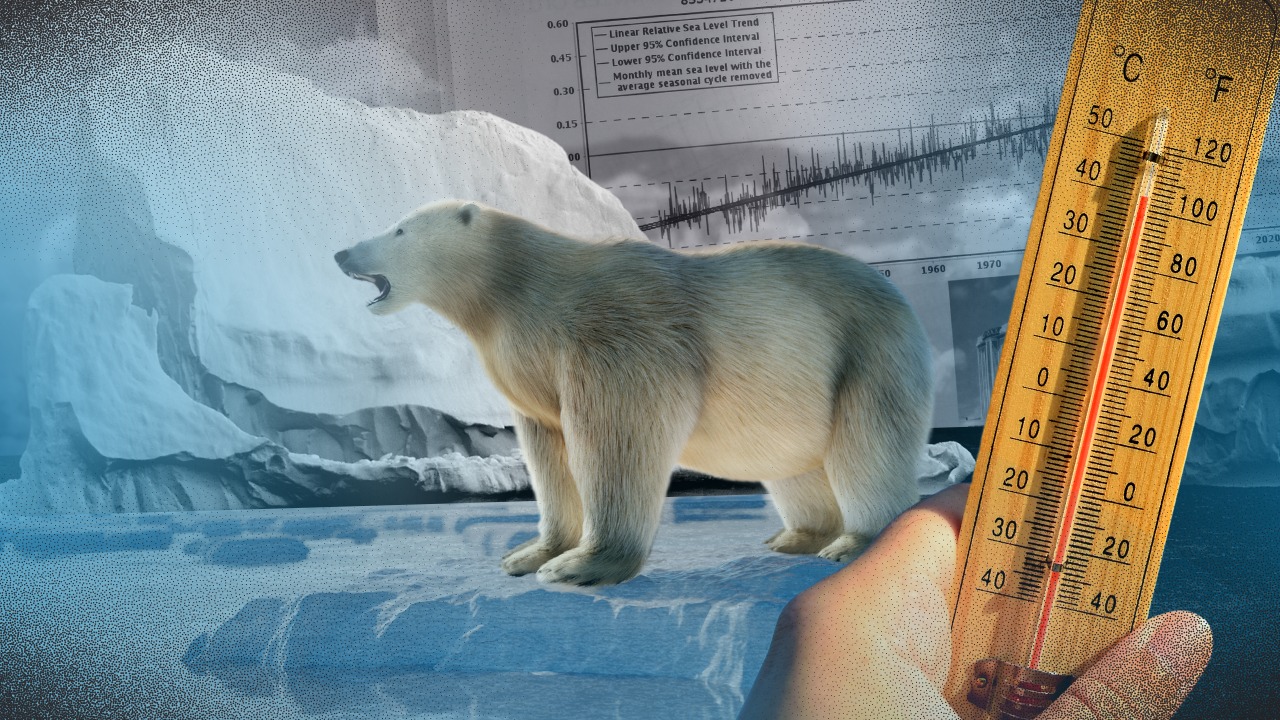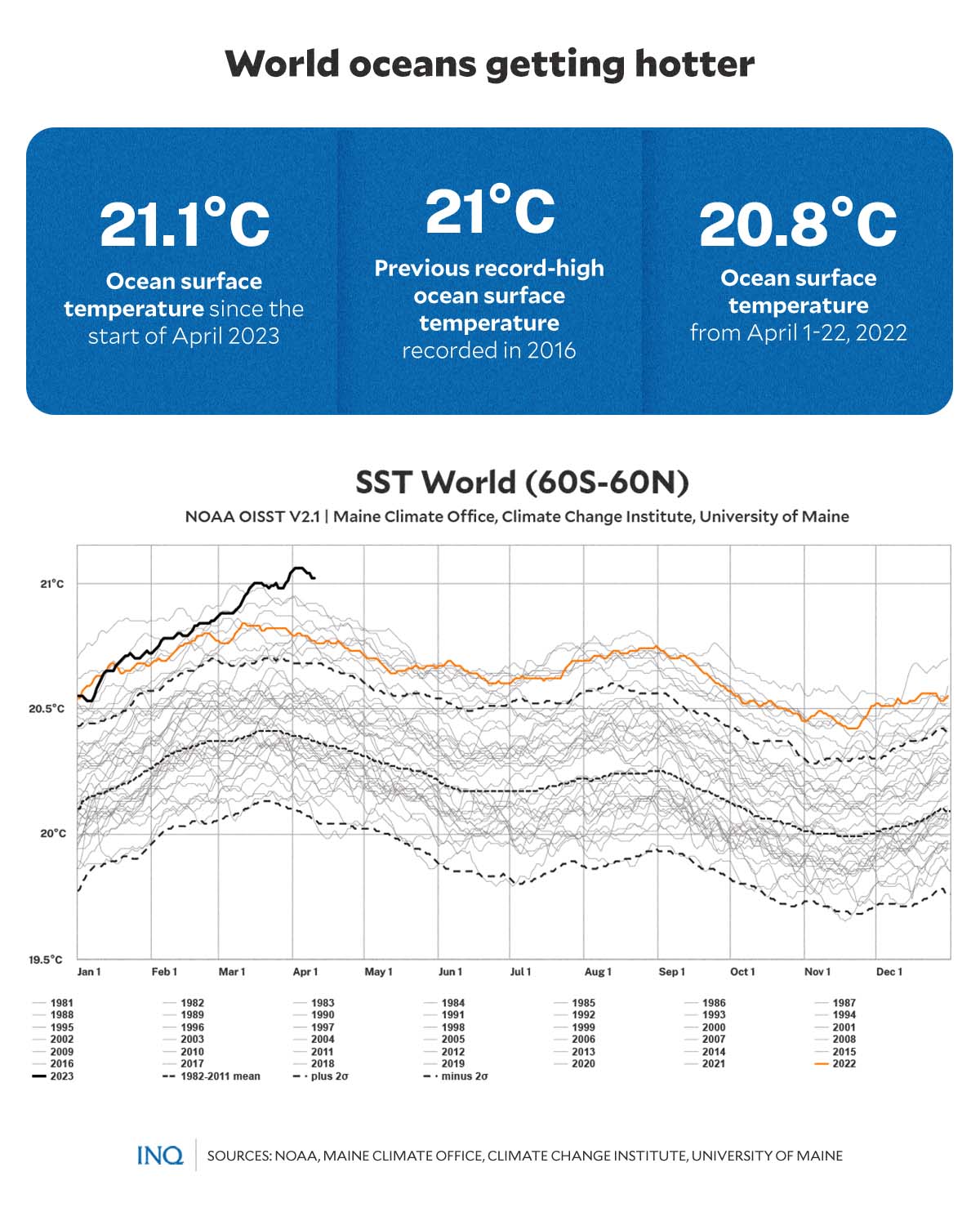(First of two parts)
MANILA, Philippines—As countries continue to find ways to tackle the devastating impacts of climate change, new data showed that the world’s ocean surface temperature has hit a new record-high—which scientists warned could lead to higher risks of extreme weather.
Studies found that global temperatures will continue to rise for many decades, mainly due to increasing greenhouse gases produced by human activities.
Scientists have predicted and warned about the effects of human-caused global warming, such as the loss of sea ice, melting glaciers and ice sheets, sea level rise, and frequent intense heat waves.
There is, however, another expected effect of global climate change which is already happening now: the rising temperature of the world’s ocean surface.
Prof. Matthew England, a climate scientist at the University of New South Wales, told the UK paper The Guardian that “the current trajectory looks like it’s headed off the charts, smashing previous records.”
Preliminary data from the National Oceanic and Atmospheric Administration (Noaa) revealed that the average temperature of the world’s ocean surface has been 21.1°C since the start of April this year.
The recorded temperature is a new record-high and has surpassed the previous high ocean surface temperature of 21°C recorded in 2016. Scientists warned that increasing ocean temperatures could cause marine heatwaves and a higher risk of extreme weather.
What happened?
Since the pre-industrial period—between 1850 and 1900—the increase in human activities, mainly fossil fuel burning, has led to increased heat-trapping greenhouse levels in the Earth’s atmosphere.
Most of the excess atmospheric heat, Noaa explained, is then passed back to the ocean—which causes a rise in the temperature of the ocean’s surface or higher upper ocean heat content. But how exactly did it happen?
The ocean, which covers over two-thirds of the world’s surface, absorbs huge quantities of heat as a result of the rising concentrations of greenhouse gases in the atmosphere.
“The ocean’s ability to absorb excess heat has shielded humans from even more rapid changes in climate. Without this oceanic buffer, global temperatures would have risen much more than they have done to date,” said the International Union for Conservation of Nature (IUCN).
The Fifth Assessment Report published by the Intergovernmental Panel on Climate Change (IPCC) in 2013 showed that the ocean had absorbed over 93 percent of excess heat from greenhouse gas emissions since the 1970s—resulting in increasing global ocean surface temperatures.
In 2022, global ocean surface temperatures were 0.69°C higher than the 20th-century average. Data from Noaa also showed that from April 1 to 22 last year, the ocean’s surface temperature was 20.8°C.
Alarmingly, scientists have pointed out that while heat absorbed by the ocean moves from one place to another, it does not dissipate.
“The heat energy eventually re-enters the rest of the Earth system by melting ice shelves, evaporating water, or directly reheating the atmosphere,” Noaa stressed.
“Thus, heat energy in the ocean can warm the planet for decades after it was absorbed,” it added.
This means that as the ocean absorbs more heat than it can release, its heat content increases, which could cause extreme events, affecting marine species, ecosystems, and humans.
Devastating impacts
Scientists stressed that high ocean surface temperature could increase the risk of extreme weather conditions in the years to come—including more intense El Niño events, which can bring more droughts and floods.
“The recent ‘triple dip’ La Niña has come to an end. This prolonged period of cold was tamping down global mean surface temperatures despite the rise of greenhouse gases in the atmosphere,” Noaa senior research scientist Dr. Mike McPhaden told The Guardian.
“Now that it’s over, we are likely seeing the climate change signal coming through loud and clear,” he added.
High ocean surface temperatures could also lead to deoxygenation—the reduction in the amount of oxygen dissolved in the ocean—and sea level rise due to the thermal expansion of seawater and continental ice melting.
Recent data from the World Wildlife Fund (WWF) showed that the Greenland ice sheet is disappearing four times faster than it did in 2003 and has already contributed 20 percent of the current sea level rise.
READ: Record ice melt in Greenland: Why should we care?
Moreover, rising ocean surface temperatures paired with ocean acidification—the decrease in pH levels of the ocean due to its uptake of carbon dioxide—could affect marine species and ecosystems.
“Marine fishes, seabirds and marine mammals all face very high risks from increasing temperatures, including high levels of mortalities, loss of breeding grounds and mass movements as species search for favourable environmental conditions,” IUCN explained.
“Coral reefs are also affected by increasing temperatures which cause coral bleaching and increase their risk of mortality,” it added.
What can be done
According to IUCN, several adaptive and precautionary measures could still protect ocean ecosystems and minimize the impact of ocean warming on humans.
These include:
- Limiting greenhouse gas emissions—achieve targets set by the Paris Agreement on climate change and hold the increase in the global average temperature to well below 2°C above pre-industrial levels.
- Protecting marine and coastal ecosystems—protected and well-managed areas can help conserve and protect ecologically and biologically significant marine habitats.
- Restoring marine and coastal ecosystems—restore elements of ecosystems that have already experienced damage. This involves creating surrogate habitats for organisms or boosting the resilience of species to warmer temperatures.
- Improving human adaption—governments can introduce policies to keep fisheries production within sustainable limits. The use of new monitoring tools can be developed to forecast and control marine disease outbreaks.
- Strengthening scientific research—investments in scientific research that help measure and monitor ocean warming and its effects must be increased and supported by the government.



